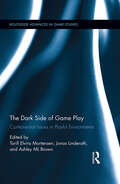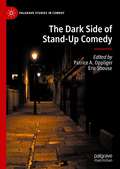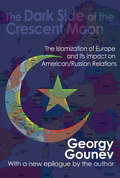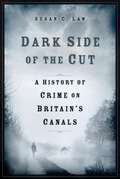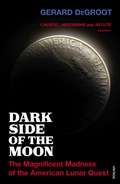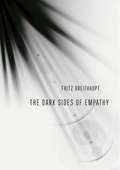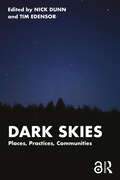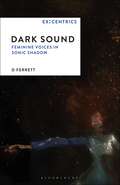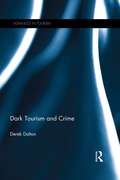- Table View
- List View
The Dark Side of Camp Aesthetics: Queer Economies of Dirt, Dust and Patina (Routledge Research in Cultural and Media Studies)
by Ingrid Hotz-Davies Franziska Bergmann Georg Vogt"Camp" is often associated with glamour, surfaces and an ostentatious display of chic, but as these authors argue, there is an underside to it that has often gone unnoticed: camp’s simultaneous investment in dirt, vulgarity, the discarded and rejected, the abject. This book explores how camp challenges and at the same time celebrates what is arguably the single most important and foundational cultural division, that between the dirty and the clean. In refocusing camp as a phenomenon of the dark underside as much as of the glamorous surface, the collection hopes to offer an important contribution to our understanding of the cultural politics and aesthetics of camp.
The Dark Side of Camp Aesthetics: Queer Economies of Dirt, Dust and Patina (Routledge Research in Cultural and Media Studies)
by Ingrid Hotz-Davies Georg Vogt Franziska Bergmann"Camp" is often associated with glamour, surfaces and an ostentatious display of chic, but as these authors argue, there is an underside to it that has often gone unnoticed: camp’s simultaneous investment in dirt, vulgarity, the discarded and rejected, the abject. This book explores how camp challenges and at the same time celebrates what is arguably the single most important and foundational cultural division, that between the dirty and the clean. In refocusing camp as a phenomenon of the dark underside as much as of the glamorous surface, the collection hopes to offer an important contribution to our understanding of the cultural politics and aesthetics of camp.
The Dark Side of Early Soviet Childhood, 1917-1941: Repressed Children
by Dr Boris B. GorshkovThe Civil War and early Soviet food policies left millions of children homeless and starving in Russia in the first half of the 20th century. Child mortality rates reached 95% in certain areas, and all of these problems remained endemic throughout the 1920s and 1930s. In The Dark Side of Early Soviet Childhood, 1917-1941, Boris B. Gorshkov investigates the causes of this prolonged homelessness and starvation, the conditions faced by huge numbers of children, and the state's unsuccessful efforts to solve these horrendous issues. Gorshkov pays particular attention to the critical role of the secret police (the VChKa and the NKVD) in this story and draws on a range of previously unused archival sources to reveal the full extent of the suffering of children in Russia at this time, as well as the interconnected causes behind it.
The Dark Side of Early Soviet Childhood, 1917-1941: Repressed Children
by Dr Boris B. GorshkovThe Civil War and early Soviet food policies left millions of children homeless and starving in Russia in the first half of the 20th century. Child mortality rates reached 95% in certain areas, and all of these problems remained endemic throughout the 1920s and 1930s. In The Dark Side of Early Soviet Childhood, 1917-1941, Boris B. Gorshkov investigates the causes of this prolonged homelessness and starvation, the conditions faced by huge numbers of children, and the state's unsuccessful efforts to solve these horrendous issues. Gorshkov pays particular attention to the critical role of the secret police (the VChKa and the NKVD) in this story and draws on a range of previously unused archival sources to reveal the full extent of the suffering of children in Russia at this time, as well as the interconnected causes behind it.
The Dark Side of Family Communication: The Harmful, The Morally Suspect, And The Socially Inappropriate (Key Themes in Family Communication #5)
by Loreen N. Olson Elizabeth A. Baiocchi-Wagner Jessica M. Wilson-Kratzer Sarah E. SymondsThis text provides for the first time in book form an exploration of the communicative aspects of the darker side of family life, ranging from, for example, severe acts of violence to more subtle forms of conflict. In addition to offering a working definition of the concept of the "dark side" in the family context, the authors propose the Darkness Model of Family Communication that integrates relevant literature in new and significant ways. Researchers, teachers and advanced students alike will benefit from the holistic and theoretical approach to the topic advanced through this volume. Readers are also encouraged to process the material by reviewing discussion questions and the case study of the Moore family at the end of each chapter. Chapter topics include: an overview of the "dark side" of family communication individual influences on the darkness of family communication the dark side of dyadic family life familial interaction structure and the dark side dark family communication in a context of darkness - socio-cultural influences on family life concluding reflections on the study of dark family communication The Dark Side of Family Communication offers an integrative understanding of the dark side of family communication and a theoretical mechanism for understanding related scholarship. It will be essential reading for all students and scholars of family communication.
The Dark Side of Game Play: Controversial Issues in Playful Environments (Routledge Advances in Game Studies)
by Torill Elvira Mortensen Jonas Linderoth Ashley Ml BrownGames allow players to experiment and play with subject positions, values and moral choice. In game worlds players can take on the role of antagonists; they allow us to play with behaviour that would be offensive, illegal or immoral if it happened outside of the game sphere. While contemporary games have always handled certain problematic topics, such as war, disasters, human decay, post-apocalyptic futures, cruelty and betrayal, lately even the most playful of genres are introducing situations in which players are presented with difficult ethical and moral dilemmas. This volume is an investigation of "dark play" in video games, or game play with controversial themes as well as controversial play behaviour. It covers such questions as: Why do some games stir up political controversies? How do games invite, or even push players towards dark play through their design? Where are the boundaries for what can be presented in a games? Are these boundaries different from other media such as film and books, and if so why? What is the allure of dark play and why do players engage in these practices?
The Dark Side of Game Play: Controversial Issues in Playful Environments (Routledge Advances in Game Studies)
by Torill Elvira Mortensen Jonas Linderoth Ashley Ml BrownGames allow players to experiment and play with subject positions, values and moral choice. In game worlds players can take on the role of antagonists; they allow us to play with behaviour that would be offensive, illegal or immoral if it happened outside of the game sphere. While contemporary games have always handled certain problematic topics, such as war, disasters, human decay, post-apocalyptic futures, cruelty and betrayal, lately even the most playful of genres are introducing situations in which players are presented with difficult ethical and moral dilemmas. This volume is an investigation of "dark play" in video games, or game play with controversial themes as well as controversial play behaviour. It covers such questions as: Why do some games stir up political controversies? How do games invite, or even push players towards dark play through their design? Where are the boundaries for what can be presented in a games? Are these boundaries different from other media such as film and books, and if so why? What is the allure of dark play and why do players engage in these practices?
The Dark Side of Podemos?: Carl Schmitt and Contemporary Progressive Populism (Routledge Advances in Sociology)
by Josh Booth Patrick BaertIn 2014 a new progressive party, Podemos, emerged on the Spanish political scene. Within just over two years it had become the country’s third-biggest party, winning a slew of seats in parliament and regularly making headline news. While some see Podemos as the saviour of Spanish democracy, others have accused it of corrosive populism. But what few have noticed is that behind its distinctive rhetoric lies a thinker closely associated with Germany’s Third Reich: Carl Schmitt. Why has an ostensibly progressive and avowedly anti-fascist political party taken up Schmitt’s ideas? The puzzle only deepens when we learn of Schmitt’s links with Francisco Franco’s dictatorship. In The Dark Side of Podemos?, Booth and Baert explain why Schmittian theory resonated with Podemos’ founders. In doing so, the authors position Podemos and the ideas that guide it within the context of recent Spanish history and ongoing politics of memory, revealing a story about how personal and political narratives have combined to produce a formidable political force. This enlightening monograph will appeal to undergraduates and postgraduates, as well as postdoctoral researchers, interested in fields such as Politics, Political Theory and Sociology. It will also be relevant to those curious about contemporary Spanish politics, the nature of populism, the future of the European left, or Carl Schmitt and his links with Spain.
The Dark Side of Podemos?: Carl Schmitt and Contemporary Progressive Populism (Routledge Advances in Sociology)
by Josh Booth Patrick BaertIn 2014 a new progressive party, Podemos, emerged on the Spanish political scene. Within just over two years it had become the country’s third-biggest party, winning a slew of seats in parliament and regularly making headline news. While some see Podemos as the saviour of Spanish democracy, others have accused it of corrosive populism. But what few have noticed is that behind its distinctive rhetoric lies a thinker closely associated with Germany’s Third Reich: Carl Schmitt. Why has an ostensibly progressive and avowedly anti-fascist political party taken up Schmitt’s ideas? The puzzle only deepens when we learn of Schmitt’s links with Francisco Franco’s dictatorship. In The Dark Side of Podemos?, Booth and Baert explain why Schmittian theory resonated with Podemos’ founders. In doing so, the authors position Podemos and the ideas that guide it within the context of recent Spanish history and ongoing politics of memory, revealing a story about how personal and political narratives have combined to produce a formidable political force. This enlightening monograph will appeal to undergraduates and postgraduates, as well as postdoctoral researchers, interested in fields such as Politics, Political Theory and Sociology. It will also be relevant to those curious about contemporary Spanish politics, the nature of populism, the future of the European left, or Carl Schmitt and his links with Spain.
The Dark Side of Stand-Up Comedy (Palgrave Studies in Comedy)
by Patrice A. Oppliger Eric ShouseThis book focuses on the “dark side” of stand-up comedy, initially inspired by speculations surrounding the death of comedian Robin Williams. Contributors, those who study humor as well as those who perform comedy, join together to contemplate the paradoxical relationship between tragedy and comedy and expose over-generalizations about comic performers’ troubled childhoods, addictions, and mental illnesses. The book is divided into two sections. First, scholars from a variety of disciplines explore comedians’ onstage performances, their offstage lives, and the relationship between the two. The second half of the book focuses on amateur and lesser-known professional comedians who reveal the struggles they face as they attempt to hone successful comedy acts and likable comic personae. The goal of this collection is to move beyond the hackneyed stereotype of the sad clown in order to reveal how stand-up comedy can transform both personal and collective tragedies by providing catharsis through humor.
The Dark Side of the Crescent Moon: The Islamization of Europe and its Impact on American/Russian Relations
by Georgy GounevThe Dark Side of the Crescent Moon constitutes a historical and political analysis of the growth of radical Islam throughout the world. It shows how the spread of radical Islam in Europe drove the United States and Russia to become allies of necessity, in order to confront a shared danger. Georgy Gounev provides readers with a detailed assessment of the people, countries, and global movements that factor into Islam's mounting threat.From the evolution and history of radical Islam to the role of the United States and Russia in the rise of Islam, the author lays out the factors contributing to this global phenomenon. Taking the reader from Chechnya and Kosovo, to Sudan and Somalia, to Afghanistan and Iraq, Gounev explores the motivations that lurk beneath the surface of active conflict, and extend the threat to the shores of Britain, Russia, and even the United States. He illuminates the vast network that is actively transmitting the political and religious dogma of radical Islam. Casting a cold eye on the theocratic fundamentalism emanating from Iran and Saudi Arabia, Gounev sounds an alarm about a growing threat both outside and inside our borders.
The Dark Side of the Crescent Moon: The Islamization of Europe and its Impact on American/Russian Relations
by Georgy GounevThe Dark Side of the Crescent Moon constitutes a historical and political analysis of the growth of radical Islam throughout the world. It shows how the spread of radical Islam in Europe drove the United States and Russia to become allies of necessity, in order to confront a shared danger. Georgy Gounev provides readers with a detailed assessment of the people, countries, and global movements that factor into Islam's mounting threat.From the evolution and history of radical Islam to the role of the United States and Russia in the rise of Islam, the author lays out the factors contributing to this global phenomenon. Taking the reader from Chechnya and Kosovo, to Sudan and Somalia, to Afghanistan and Iraq, Gounev explores the motivations that lurk beneath the surface of active conflict, and extend the threat to the shores of Britain, Russia, and even the United States. He illuminates the vast network that is actively transmitting the political and religious dogma of radical Islam. Casting a cold eye on the theocratic fundamentalism emanating from Iran and Saudi Arabia, Gounev sounds an alarm about a growing threat both outside and inside our borders.
Dark Side of the Cut: A History of Crime on Britain's Canals
by Susan C. LawCanals were the lifeblood of the Industrial Revolution, but prosperity had its price: crime. From the earliest days, canals had a shady reputation, and in Victorian Britain disturbing facts emerged to reveal the hidden side of the water, isolated places where sinister figures lurked in the shadows. When a brutal murder in 1839 created a national outcry, it seemed to confirm all the worst fears about boatmen, a tough breed of men surviving harsh conditions, who enforced their own kind of rough justice, and were swiftly branded as outlaws by the press. Drawing on a rich collection of original sources, this new study by historian Susan Law brings to life dramatic stories, gruesome, shocking and tragic. These evocative snapshots uncover the secret world of the waterways set apart on the edge of society, to reveal the real human cost of the Industrial Revolution.
The Dark Side of the Internet: Protecting Yourself and Your Family from Online Criminals
by Paul BocijIn less than a decade, personal computers have become part of our daily lives. Many of us come into contact with computers every day, whether at work, school or home. As useful as the new technologies are, they also have a darker side. By making computers part of our daily lives, we run the risk of allowing thieves, swindlers, and all kinds of deviants directly into our homes. Armed with a personal computer, a modem and just a little knowledge, a thief can easily access confidential information, such as details of bank accounts and credit cards. This book helps people avoid harm at the hands of Internet criminals. It offers a tour of the more dangerous parts of the Internet, as the author explains who the predators are, their motivations, how they operate and how to protect against them.In less than a decade, personal computers have become part of our daily lives. Many of us come into contact with computers every day, whether at work, school or home. As useful as the new technologies are, they also have a darker side. By making computers part of our daily lives, we run the risk of allowing thieves, swindlers, and all kinds of deviants directly into our homes. Armed with a personal computer, a modem and just a little knowledge, a thief can easily access confidential information, such as details of bank accounts and credit cards. This book is intended to help people avoid harm at the hands of Internet criminals. It offers a tour of the more dangerous parts of the Internet, as the author explains who the predators are, their motivations, how they operate and how to protect against them.Behind the doors of our own homes, we assume we are safe from predators, con artists, and other criminals wishing us harm. But the proliferation of personal computers and the growth of the Internet have invited these unsavory types right into our family rooms. With a little psychological knowledge a con man can start to manipulate us in different ways. A terrorist can recruit new members and raise money over the Internet. Identity thieves can gather personal information and exploit it for criminal purposes. Spammers can wreak havoc on businesses and individuals. Here, an expert helps readers recognize the signs of a would-be criminal in their midst. Focusing on the perpetrators, the author provides information about how they operate, why they do it, what they hope to do, and how to protect yourself from becoming a victim.
Dark Side of the Moon: The Magnificent Madness of the American Lunar Quest
by Gerard DeGrootFor a very brief moment during the 1960s, America was moonstruck. Every boy dreamed of being an astronaut; every girl dreamed of marrying one. But despite the best efforts of a generation of scientists, the almost foolhardy heroics of the astronauts, and 35 billion dollars, the moon turned out to be a place of 'magnificent desolation', to use Buzz Aldrin's words.In Dark Side of the Moon, Gerard DeGroot reveals how NASA cashed in on the Americans' thirst for heroes in an age of discontent and became obsessed with putting a man on the moon, in the process limiting what could be acheived in space. Drawing on meticulous archival research, DeGroot cuts through the propaganda peddled by the Eisenhower, Kennedy and Johnson administrations - not to mention the NASA spin doctors - and exposes the truth behind one of the most revered myths of American history.
The Dark Sides of Empathy
by Fritz BreithauptMany consider empathy to be the basis of moral action. However, the ability to empathize with others is also a prerequisite for deliberate acts of humiliation and cruelty. In The Dark Sides of Empathy, Fritz Breithaupt contends that people often commit atrocities not out of a failure of empathy but rather as a direct consequence of over-identification and a desire to increase empathy. Even well-meaning compassion can have many unintended consequences, such as intensifying conflicts or exploiting others.Empathy plays a central part in a variety of highly problematic behaviors. From mere callousness to terrorism, exploitation to sadism, and emotional vampirism to stalking, empathy all too often motivates and promotes malicious acts. After tracing the development of empathy as an idea in German philosophy, Breithaupt looks at a wide-ranging series of case studies—from Stockholm syndrome to Angela Merkel's refugee policy and from novels of the romantic era to helicopter parents and murderous cheerleader moms—to uncover how narcissism, sadism, and dangerous celebrity obsessions alike find their roots in the quality that, arguably, most makes us human.
Dark Skies: Places, Practices, Communities
by Nick Dunn Tim EdensorDark Skies addresses a significant gap in knowledge in relation to perspectives from the arts, humanities, and social sciences. In providing a new multi- and interdisciplinary field of inquiry, this book brings together engagements with dark skies from a variety of disciplinary backgrounds, empirical studies, and theoretical orientations. Throughout history, the relationship with dark skies has generated a sense of wonder and awe, as well as providing the basis for important cultural meanings and spiritual beliefs. However, the connection to darks skies is now under threat due to the widespread growth of light pollution and the harmful impacts that this has upon humans, non-humans, and the planet we share. This book, therefore, examines the rich potential of dark skies and their relationships with place, communities, and practices to provide new insights and understandings on their importance for our world in an era of climate emergency and environmental degradation. This book is intended for a wide audience. It will be of interest to scholars, students, and professionals in geography, design, astronomy, anthropology, ecology, history, and public policy, as well as anyone who has an interest in how we can protect the night sky for the benefit of us all and the future generations to follow.
Dark Skies: Places, Practices, Communities
Dark Skies addresses a significant gap in knowledge in relation to perspectives from the arts, humanities, and social sciences. In providing a new multi- and interdisciplinary field of inquiry, this book brings together engagements with dark skies from a variety of disciplinary backgrounds, empirical studies, and theoretical orientations. Throughout history, the relationship with dark skies has generated a sense of wonder and awe, as well as providing the basis for important cultural meanings and spiritual beliefs. However, the connection to darks skies is now under threat due to the widespread growth of light pollution and the harmful impacts that this has upon humans, non-humans, and the planet we share. This book, therefore, examines the rich potential of dark skies and their relationships with place, communities, and practices to provide new insights and understandings on their importance for our world in an era of climate emergency and environmental degradation. This book is intended for a wide audience. It will be of interest to scholars, students, and professionals in geography, design, astronomy, anthropology, ecology, history, and public policy, as well as anyone who has an interest in how we can protect the night sky for the benefit of us all and the future generations to follow.
Dark Sound: Feminine Voices in Sonic Shadow (Ex:Centrics)
by D FerrettDark sound carries the dense cultural weight of darkness; it is the undertow of music that embodies melancholy, desire, grief, violence, rage, pain, loss and longing. Compelling and unnerving, dark sound immerses bodies in the darkest moments and delves into the depths of our hidden inner selves. There is a strangely perverse appeal about music that conjures intense affective states and about sound that can move its listeners to the very edge of the sayable. Through a series of case studies that include Moor Mother, Anna Calvi, Björk, Chelsea Wolfe and Diamanda Galás, D Ferrett argues that the extreme limits and transgressions of dark sound not only imply the limits of language, but are moreover tied to a cultural and historical association between darkness and the feminine within music and music discourse. Whilst the oppressive and violent associations between darkness and femininity are acknowledged, the author challenges their value to misogynistic, racist, capitalist and patriarchal power, showing how dark sound is charged with social, creative and political momentum.
Dark Sound: Feminine Voices in Sonic Shadow (Ex:Centrics #1)
by D FerrettDark sound carries the dense cultural weight of darkness; it is the undertow of music that embodies melancholy, desire, grief, violence, rage, pain, loss and longing. Compelling and unnerving, dark sound immerses bodies in the darkest moments and delves into the depths of our hidden inner selves. There is a strangely perverse appeal about music that conjures intense affective states and about sound that can move its listeners to the very edge of the sayable. Through a series of case studies that include Moor Mother, Anna Calvi, Björk, Chelsea Wolfe and Diamanda Galás, D Ferrett argues that the extreme limits and transgressions of dark sound not only imply the limits of language, but are moreover tied to a cultural and historical association between darkness and the feminine within music and music discourse. Whilst the oppressive and violent associations between darkness and femininity are acknowledged, the author challenges their value to misogynistic, racist, capitalist and patriarchal power, showing how dark sound is charged with social, creative and political momentum.
The Dark Stuff: Stories from the Peatlands
by Donald S. MurrayDonald S. Murray spent much of his childhood either playing or working on the moor, chasing sheep across empty acres and cutting and gathering peat for fuel. The Dark Stuff is an examination of how this landscape affected him and others. Donald explores his early life on the Isle of Lewis together with the experiences of those who lived near moors much further afield, from the Highlands and Islands of Scotland to the Netherlands, Germany, Ireland and even Australia. Examining this environment in all its roles and guises, Donald reflects on the ways that for centuries humans have represented the moor in literature, art and folktale, and he reveals how in some countries, these habitats remain an essential aspect of their industrial heritage and working life today. On his journey, Donald confronts the unexpected – how Europe's peatlands are part of the dark heart of that continent, playing a crucial role in the history of crime and punishment in several countries. He also examines our current perception of moorland, asking how – for the sake, perhaps, of our planet's survival – we can learn to love a landscape we have all too often in our history denigrated, feared and despised.
The Dark Stuff: Stories from the Peatlands
by Donald S. MurrayDonald S. Murray spent much of his childhood either playing or working on the moor, chasing sheep across empty acres and cutting and gathering peat for fuel. The Dark Stuff is an examination of how this landscape affected him and others. Donald explores his early life on the Isle of Lewis together with the experiences of those who lived near moors much further afield, from the Highlands and Islands of Scotland to the Netherlands, Germany, Ireland and even Australia. Examining this environment in all its roles and guises, Donald reflects on the ways that for centuries humans have represented the moor in literature, art and folktale, and he reveals how in some countries, these habitats remain an essential aspect of their industrial heritage and working life today. On his journey, Donald confronts the unexpected – how Europe's peatlands are part of the dark heart of that continent, playing a crucial role in the history of crime and punishment in several countries. He also examines our current perception of moorland, asking how – for the sake, perhaps, of our planet's survival – we can learn to love a landscape we have all too often in our history denigrated, feared and despised.
Dark Thoughts: Race and the Eclipse of Society
by Charles LemertIn Dark Thoughts, eminent sociologist Charles Lemert dares to say, and explain, what everyone already knows - that the modern world was built on the need of white people to pretend they are not as dark as the next person.Delving poignantly into the history and literature of domination, Lemert retells key moments of the twentieth-century by profiling figures like W.E.B. DuBois, Charlotte Perkins Gilman, Anna Julia Cooper, Nella Larson, Malcolm X, and Muhammad Ali. In a rare and unflinching look at his own complicated history, Lemert also explores his own racism, his struggle with the suicide of his oldest son, as well as growing up as the virtual son of a black mother and his life now as the real father of an African-American daughter. Dark Thoughts speaks to the most urgent social issues at the beginning of the twenty-first century: race relations, multiculturalism, and social justice.
Dark Thoughts: Race and the Eclipse of Society
by Charles LemertIn Dark Thoughts, eminent sociologist Charles Lemert dares to say, and explain, what everyone already knows - that the modern world was built on the need of white people to pretend they are not as dark as the next person.Delving poignantly into the history and literature of domination, Lemert retells key moments of the twentieth-century by profiling figures like W.E.B. DuBois, Charlotte Perkins Gilman, Anna Julia Cooper, Nella Larson, Malcolm X, and Muhammad Ali. In a rare and unflinching look at his own complicated history, Lemert also explores his own racism, his struggle with the suicide of his oldest son, as well as growing up as the virtual son of a black mother and his life now as the real father of an African-American daughter. Dark Thoughts speaks to the most urgent social issues at the beginning of the twenty-first century: race relations, multiculturalism, and social justice.
Dark Tourism and Crime (Advances in Tourism)
by Derek DaltonDark tourism has become widespread and diverse. It has passed into popular culture vernacular, deployed in guide books as a short hand descriptor for sites that are associated with death, suffering and trauma. However, whilst books have been devoted to dark tourism as a general topic no single text has sought to explore dark tourism in spaces where crime - mass murder, genocide, State sanctioned torture and violence - has occurred as an organising theme. Dark Tourism and Crime explores the socio-cultural contours of this unique type of tourism and explains why spaces/places where crime has occurred fascinate and attract tourists. The book is marked by an ethics of respect for the suffering a place has experienced and an imperative to learn something tangible about the history and legacy of that suffering. Based on empirical ethnographic research it takes the reader from the remnants of Auschwitz concentration camp to the tranquil Australian island of Tasmania to explore precisely what things a dark tourist might encounter - architecture, art installations, gardens, memorials, physical traces of crime - and how these things invoke and evoke past crimes. This volume furthers understanding of dark tourism and will be of interest to students, researchers and academics of criminology, tourism and cultural studies.



